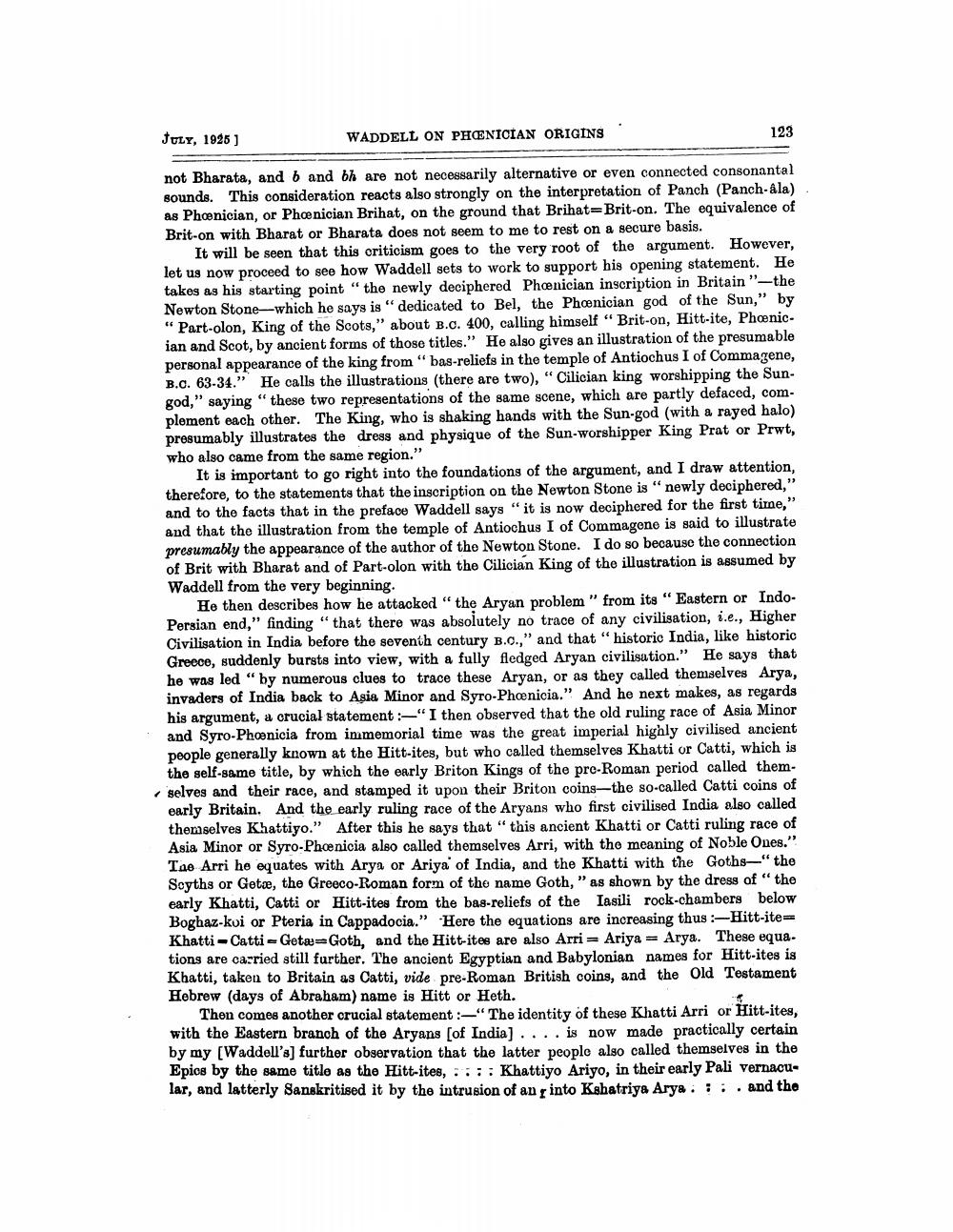________________
JULY, 1925)
WADDELL ON PHOENICIAN ORIGINS
123
not Bharata, and b and bh are not necessarily alternative or even connected consonantal sounds. This consideration reacts also strongly on the interpretation of Panch (Panch-ala) as Phoenician, or Phoenician Brihat, on the ground that Brihat=Brit-on. The equivalence of Brit-on with Bharat or Bharata does not seem to me to rest on a secure basis.
It will be seen that this criticism goes to the very root of the argument. However, let us now proceed to see how Waddell sets to work to support his opening statement. He takes as his starting point "the newly deciphered Phænician inscription in Britain -the Newton Stone-which he says is " dedicated to Bel, the Phoenician god of the Sun," by "Part-olon, King of the Scots," about B.C. 400, calling himself "Brit-on, Hitt-ite, Phoenician and Scot, by ancient forms of those titles." He also gives an illustration of the presumable personal appearance of the king from "bas-reliefs in the temple of Antiochus I of Commagene, B.C. 63-34." He calls the illustrations (there are two), “Cilician king worshipping the Sungod," saying "these two representations of the same scene, which are partly defaced, complement each other. The King, who is shaking hands with the Sun-god (with a rayed halo) presumably illustrates the dress and physique of the Sun-worshipper King Prat or Prwt, who also came from the same region."
It is important to go right into the foundations of the argument, and I draw attention, therefore, to the statements that the inscription on the Newton Stone is " newly deciphered," and to the facts that in the preface Waddell says "it is now deciphered for the first time," and that the illustration from the temple of Antiochus I of Commagene is said to illustrate presumably the appearance of the author of the Newton Stone. I do so because the connection of Brit with Bharat and of Part-olon with the Cilician King of the illustration is assumed by Waddell from the very beginning.
He then describes how he attacked "the Aryan problem " from its “Eastern or IndoPersian end," finding "that there was absolutely no trace of any civilisation, i.e., Higher Civilisation in India before the seventh century B.C.," and that "historic India, like historic Greece, suddenly bursts into view, with a fully fledged Aryan civilisation." He says that he was led "by numerous clues to trace these Aryan, or as they called themselves Arya, invaders of India back to Asia Minor and Syro-Phoenicia." And he next makes, as regards his argument, a crucial statement :-"I then observed that the old ruling race of Asia Minor and Syro-Phoenicia from immemorial time was the great imperial highly civilised ancient people generally known at the Hitt-ites, but who called themselves Khatti or Catti, which is the self-same title, by which the early Briton Kings of the pre-Roman period called themselves and their race, and stamped it upon their Briton coins-the so-called Catti coins of early Britain. And the early ruling race of the Aryans who first civilised India also called themselves Khattiyo." After this he says that "this ancient Khatti or Catti ruling race of Asia Minor or Syro-Phoenicia also called themselves Arri, with the meaning of Noble Ones.” Tae Arri he equates with Arya or Ariya of India, and the Khatti with the Goths-"the Soyths or Getre, the Greeco-Roman form of the name Goth, "as shown by the dress of "the early Khatti, Catti or Hitt-ites from the bas-reliefs of the Iasili rock-chambers below Boghaz-kui or Pteria in Cappadocia." "Here the equations are increasing thus :-Hitt-ite= Khatti - Catti-Geta - Goth, and the Hitt-ites are also Arri Ariya = Arya. These equa. tions are carried still further. The ancient Egyptian and Babylonian names for Hitt-ites is Khatti, taken to Britain as Catti, vide pre-Roman British coins, and the Old Testament Hebrew (days of Abraham) name is Hitt or Heth.
Then comes another crucial statement :-"The identity of these Khatti Arri or Hitt-ites, with the Eastern branch of the Aryans (of India] .... is now made practically certain by my (Waddell'a] further observation that the latter peoplo also called themselves in the Epios by the same titlo as the Hitt-ites, ::: : Khattiyo Ariyo, in their early Pali vernacular, and latterly Sanskritised it by the intrusion of an rinto Kshatriya Arya 1 i. and the




